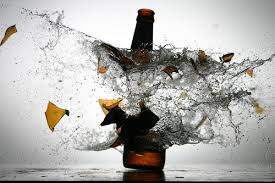Here's a fairly recent article that appeared on the
Daft Eejit Brewing website:
BEER STYLES,
HISTORY
ABOUT DAMPFBIER
NOVEMBER 22, 2020
So, the story of Dampfbier (lit. steam beer) goes like this… a 19th century Bavarian brewer who didn’t have a permit to brew with wheat malt instead brewed one with only lightly kilned barley malt and fermented it with a Weißbier yeast. As the beer was vigorously fermenting, it looked like steam coming off the beer, hence the name “Dampfbier”.
The problem here is… if a beer style’s origin story sounds too good to be true, it probably is not actually rooted in history. Naive me would simply ask why other beers like Weißbier brewed with wheat malt wouldn’t be called the same name because supposedly, the yeast would ferment as vigorous. When we actually look at historic sources though, an entirely different picture is unveiled:
One very early mention of Dampfbier can be found in
Landwirthschaftliches ConversationsLexicon für Praktiker und Laien from 1837. The meaning is a different one, though: it is used to describe beer that was brewed using steam coming from a steam boiler as a heat source for mashing as well as boiling the wort. In that particular case, brewing itself really seemed more of a side business, as most of the article is about how the steam boiler was used in a distillery in Galicia that made Polish distilled spirit from potatoes, supposedly what would be called wodka nowadays.
Philipp Heiss, former brewmaster at Spaten brewery and author of
Die Bierbrauerei mit besonderer Berücksichtigung der Dickmaischbrauerei (1853), added a small section in his book about brewing with steam. He sees two main applications: to use steam engines as a power source to steadily drive all kinds of machines in a brewery, and to use the steam as a direct or indirect heat source. He talked about several attempts to brew beer using steam, in particular brewer Zacherl (Paulaner) in Munich and Wanka in Prague, but classified both as less than successful. Heiss described Dampfbier as getting sour more quickly, and in total definitely wasn’t convinced about the technique.
Differences between beer brewed with steam vs. those with fire as heat source remained a hot topic in the decades to follow.
In Dingler’s Polytechnisches Journal, a 1889 article lists a few experimental results. At Berlin’s Versuchs- und Lehranstalt für Brauerei (VLB), the amount of fuel required to brew beer using steam was determined to be significantly less than using direct firing, certainly one good argument in favour of steam. In addition, Schloßbrauerei in Schöneberg conducted an experiment to directly compare lager beer brewed using fire with beer of the same type brewed using steam, and the differences were negligible, “contrary to the widespread prejudice that Dampfbier was less full-bodied”.
I could go one like this, but when looking at historic sources, one thing becomes very clear very quickly: Dampfbier in the 19th century purely referred to beer brewed using steam as a heat source, not barley beers fermented with Weißbier yeast.
Even when looking at more recent sources about Dampfbier, it becomes very clear that very few such beers ever existed. A few prominent examples that I was able to find were Maisel’s Dampfbier (Michael Jackson
briefly mentioned it as an “ale-like specialty”),
Dampfbier from 1. Dampfbierbrauerei Zwiesel (which also seems to be the source of the supposed origin story of the Dampfbier style), and
Borbecker Helles Dampfbier, for which is not even clear whether this is actually a top-fermented beer using Weißbier yeast. Besides these three beers, there’s not much around.
So, what can be said to vindicate the beer style? Beer brewed from pale barley malt and fermented using Weißbier yeast definitely existed and is well-documented. Friedrich Meyer mentioned Weißbier brewed from pale barley malt, sometimes with the addition of small amounts of wheat malt in his books, e.g. 1830
Die bayerische Bierbrauerei. The
1847 edition of this book even makes a distinction between weißes Gerstenbier (white barley beer) and weißes Weitzenbier (white wheat beer), but also explains that the term Weißbiercommonly refers to the former.
So, in that sense, the beer style that some people nowadays call Dampfbier definitely existed. It just used to be called Weißbier (white beer), and has nothing to do with the historic understanding of Dampfbier as a beer brewed using steam. Personally, I’m just unhappy with the term as it is confusing, it gives credence to the too-good-to-be-true origin story, and it hides the much more complex history of white beers in Bavaria.



![Craft A Brew - Safale BE-256 Yeast - Fermentis - Belgian Ale Dry Yeast - For Belgian & Strong Ales - Ingredients for Home Brewing - Beer Making Supplies - [3 Pack]](https://m.media-amazon.com/images/I/51bcKEwQmWL._SL500_.jpg)

























































